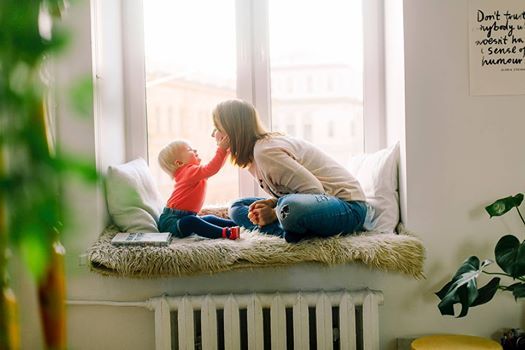Birth-3 Months
- Startles to loud sounds.
- Quiets or smiles when spoken to.
- Seems to recognize your voice and quiets if crying.
- Increases or decreases sucking behavior in response to sound.
|
Birth-3 Months
- Makes pleasure sounds (cooing, gooing).
- Cries differently for different needs.
- Smiles when sees you.
|
4-6 Months
- Moves eyes in direction of sounds.
- Responds to changes in tone of your voice.
- Notices toys that make sounds.
- Pays attention to music.
|
4-6 Months
- Babbling sounds more speech-like with many different sounds, including p, b, and m.
- Chuckles and laughs.
- Vocalizes excitement and displeasure.
- Makes gurgling sounds when left alone and when playing with you.
|
7 Months-1 Year
- Enjoys games like peek-o-boo and pat-a-cake.
- Turns and looks in direction of sounds.
- Listens when spoken to.
- Recognizes words for common items like “cup”, “shoe”, “book”, or “juice”.
- Begins to respond to requests (e.g. “Come here” or “Want more?”).
|
7 Months-1 Year
• Babbling has both long and short groups of sounds such as “tata upup
bibibibi.”
- Uses speech or non-crying sounds to get and keep attention.
- Uses gestures to communication (waving, holding arms to be picked up).
- Imitates different speech sounds.
- Has one or two words (hi, dog, dada, mama) around first birthday, although sounds may not be clear.
|
One to Two Years
- Points to a few body parts when asked.
- Follows simple commands and understands simple questions (“Roll the ball”, “Kiss the baby”, “Where’s your shoe?”).
- Listens to simple stories, songs, and rhymes.
- Points to pictures in a book when named.
|
One to Two Years
- Says more words every month.
- Uses some one- or two- word questions (“Where kitty?”, “Go bye-bye?”, “What’s that?”).
- Puts two words together (“more cookie”, “no juice”, “mommy book”).
- Uses many different consonant sounds of the beginning of words.
|
Two to Three Years
- Understands differences in meaning (“go-stop”, “in-on”, “big-little”, “up-down”).
- Follows two requests (“Get the book and put it on the table”).
- Listens to and enjoys hearing stories for longer periods of time.
|
Two to Three Years
- Has a word for almost everything.
- Uses two- or three- words to talk about and ask for things.
- Uses k, g, f, t, d, and n sounds.
- Speech is understood by familiar listeners most of the time.
- Often asks for or directs attention to objects by naming them.
- Asks why?
- May stutter on words or sounds.
|
Three to Four Years
- Hears you when call from another room.
- Hears television or radio at the same loudness level as other family members.
- Understands words for some colors, like red, blue, and green.
- Understands words for some shapes, like circle and square.
- Understands words for family, like brother, grandmother, and aunt.
|
Three to Four Years
- Talks about activities at school or at friends’ homes.
- Talks about what happened during the day. Uses about 4 sentences at a time.
- People outside of the family usually understand child’s speech.
- Answers simple, “who?”, “what?”, “where?”, and “why?” questions.
- Asks when and how questions.
- Says rhyming words, like hat-cat.
- Uses pronouns, like I, you, me, we, and they.
- Uses some plural words, like toys, birds, and buses.
- Uses a lot of sentences that have 4 or more words.
- Usually talks easily without repeating syllables or words.
|
Four to Five Years
- Understands words for order, like first, next, and last.
- Understands words for time, like yesterday, today, and tomorrow.
- Follows longer directions, like “Put your pajamas on, brush your teeth, and then pick out a book.”
- Follows classroom directions, like “Draw a circle on your paper around something you eat.”
- Hears and understands most of what is said at home and in school.
|
Four to Five Years
- Says all speech sounds in words. May make mistakes on sounds that are harder to say, like l, s, r, v, z, ch, sh, th.
- Responds to “What did you say?”
- Talks without repeating sounds or words most of the time.
- Names letters and numbers.
- Uses sentences that have more than 1 action word, like jump, play, and get. May make some mistakes, like “Zach got 2 video games, but I got one.”
- Tells a short story.
- Keeps a conversation going.
- Talks in different ways depending on the listener and place. May use short sentences with younger children or talk louder outside than inside.
|

